Mobile Commerce Innovation: Management Approach Analysis Report
VerifiedAdded on 2022/09/18
|13
|2606
|21
Report
AI Summary
This report provides an in-depth analysis of mobile commerce (m-commerce), exploring its technological innovations and impact on organizational management. It begins with an introduction to m-commerce, defining it as the buying and selling of goods and services through mobile devices, and highlighting its growth within the e-commerce landscape. The report then discusses significant milestones in m-commerce innovation, including mobile image recognition, video content availability, augmented reality apps, personalized e-commerce experiences, and the rise of NFC-based payment options. Furthermore, the report examines how these innovations have influenced management approaches, using examples like Apple and Amazon to illustrate changes in strategy and operations. The report concludes with recommendations for future development, emphasizing the adoption of agile development methodologies, focusing on mobile moments, and implementing single-click payment options. References and appendices are also included to support the findings and analysis presented in the report.
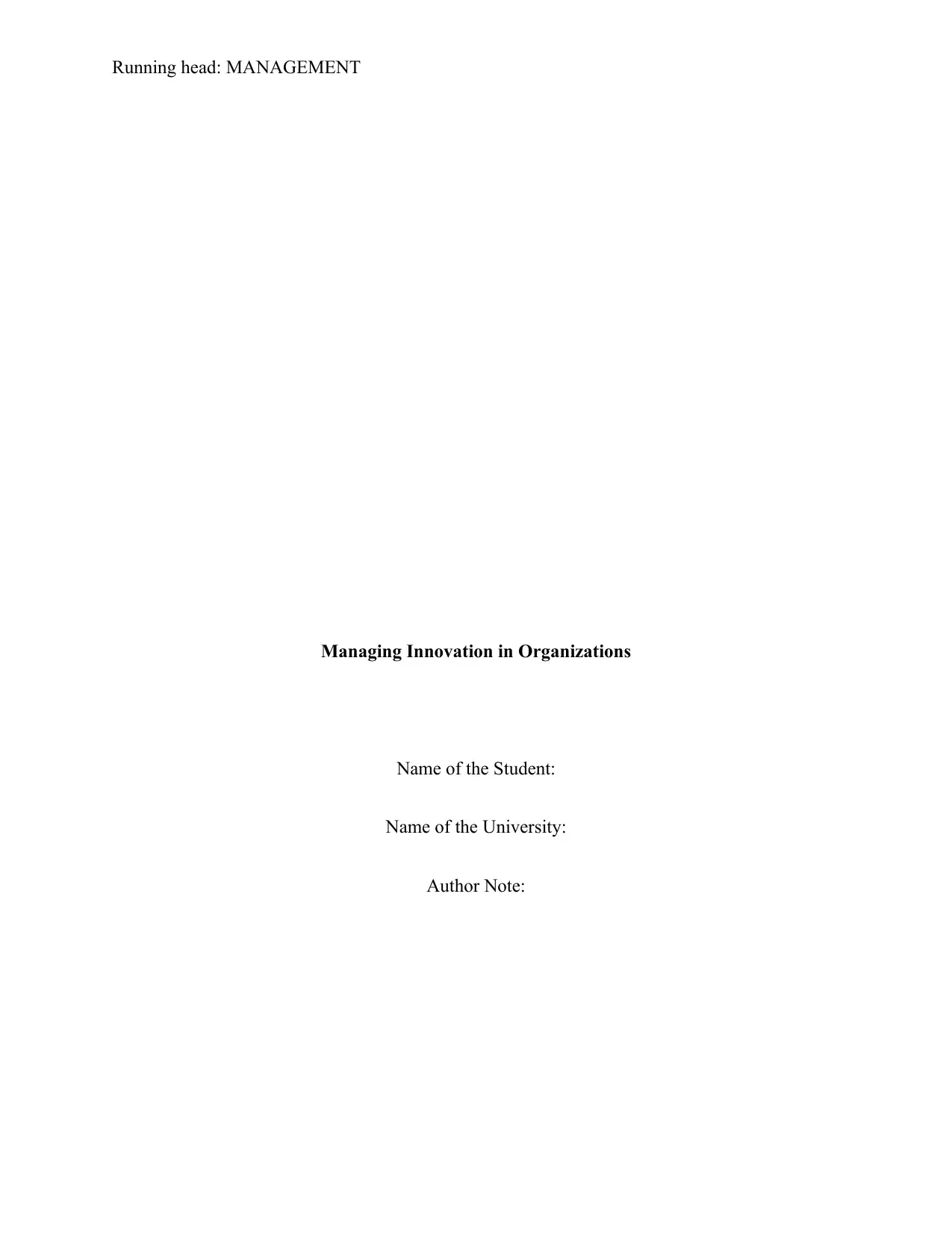
Running head: MANAGEMENT
Managing Innovation in Organizations
Name of the Student:
Name of the University:
Author Note:
Managing Innovation in Organizations
Name of the Student:
Name of the University:
Author Note:
Paraphrase This Document
Need a fresh take? Get an instant paraphrase of this document with our AI Paraphraser
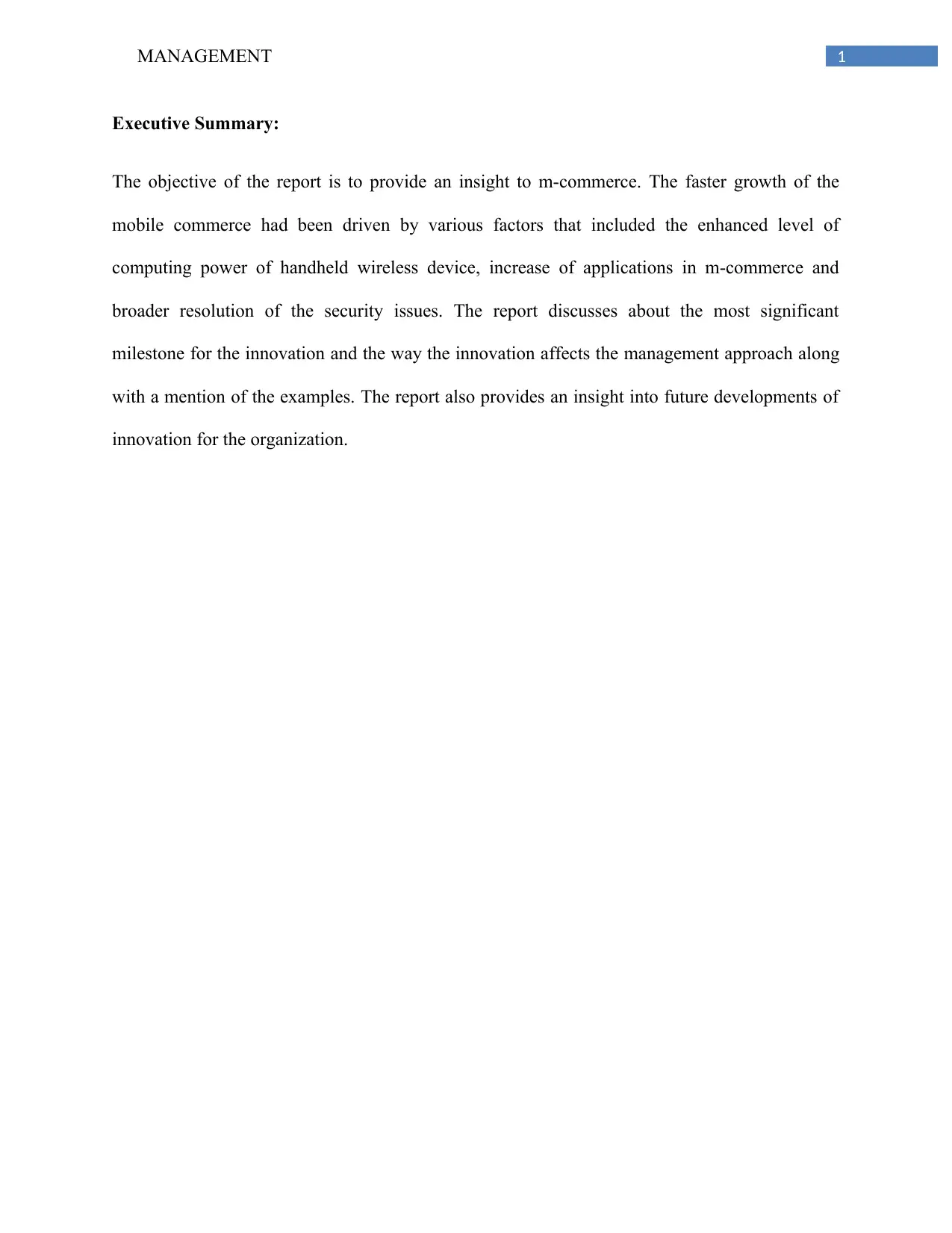
1MANAGEMENT
Executive Summary:
The objective of the report is to provide an insight to m-commerce. The faster growth of the
mobile commerce had been driven by various factors that included the enhanced level of
computing power of handheld wireless device, increase of applications in m-commerce and
broader resolution of the security issues. The report discusses about the most significant
milestone for the innovation and the way the innovation affects the management approach along
with a mention of the examples. The report also provides an insight into future developments of
innovation for the organization.
Executive Summary:
The objective of the report is to provide an insight to m-commerce. The faster growth of the
mobile commerce had been driven by various factors that included the enhanced level of
computing power of handheld wireless device, increase of applications in m-commerce and
broader resolution of the security issues. The report discusses about the most significant
milestone for the innovation and the way the innovation affects the management approach along
with a mention of the examples. The report also provides an insight into future developments of
innovation for the organization.
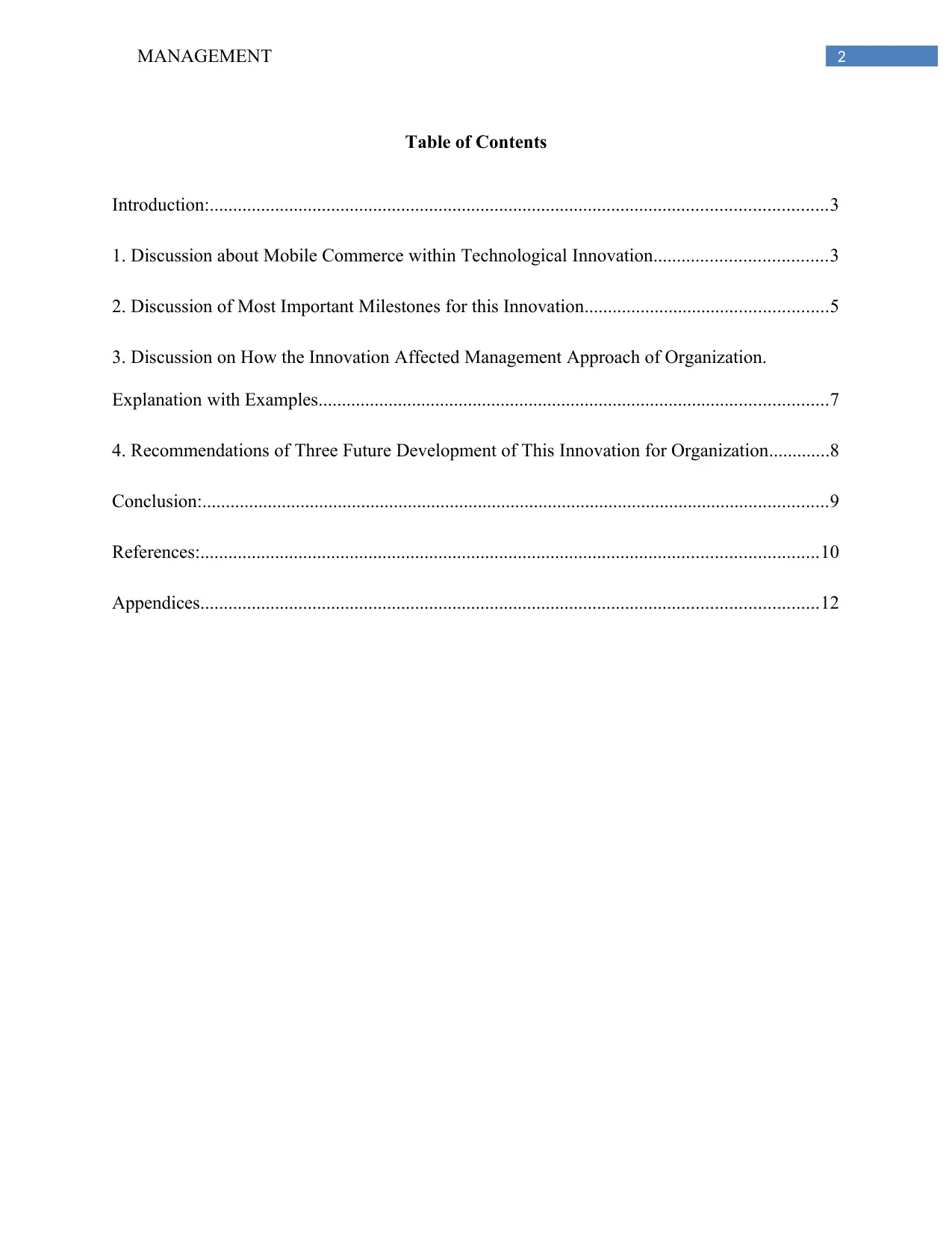
2MANAGEMENT
Table of Contents
Introduction:....................................................................................................................................3
1. Discussion about Mobile Commerce within Technological Innovation.....................................3
2. Discussion of Most Important Milestones for this Innovation....................................................5
3. Discussion on How the Innovation Affected Management Approach of Organization.
Explanation with Examples.............................................................................................................7
4. Recommendations of Three Future Development of This Innovation for Organization.............8
Conclusion:......................................................................................................................................9
References:....................................................................................................................................10
Appendices....................................................................................................................................12
Table of Contents
Introduction:....................................................................................................................................3
1. Discussion about Mobile Commerce within Technological Innovation.....................................3
2. Discussion of Most Important Milestones for this Innovation....................................................5
3. Discussion on How the Innovation Affected Management Approach of Organization.
Explanation with Examples.............................................................................................................7
4. Recommendations of Three Future Development of This Innovation for Organization.............8
Conclusion:......................................................................................................................................9
References:....................................................................................................................................10
Appendices....................................................................................................................................12
⊘ This is a preview!⊘
Do you want full access?
Subscribe today to unlock all pages.

Trusted by 1+ million students worldwide
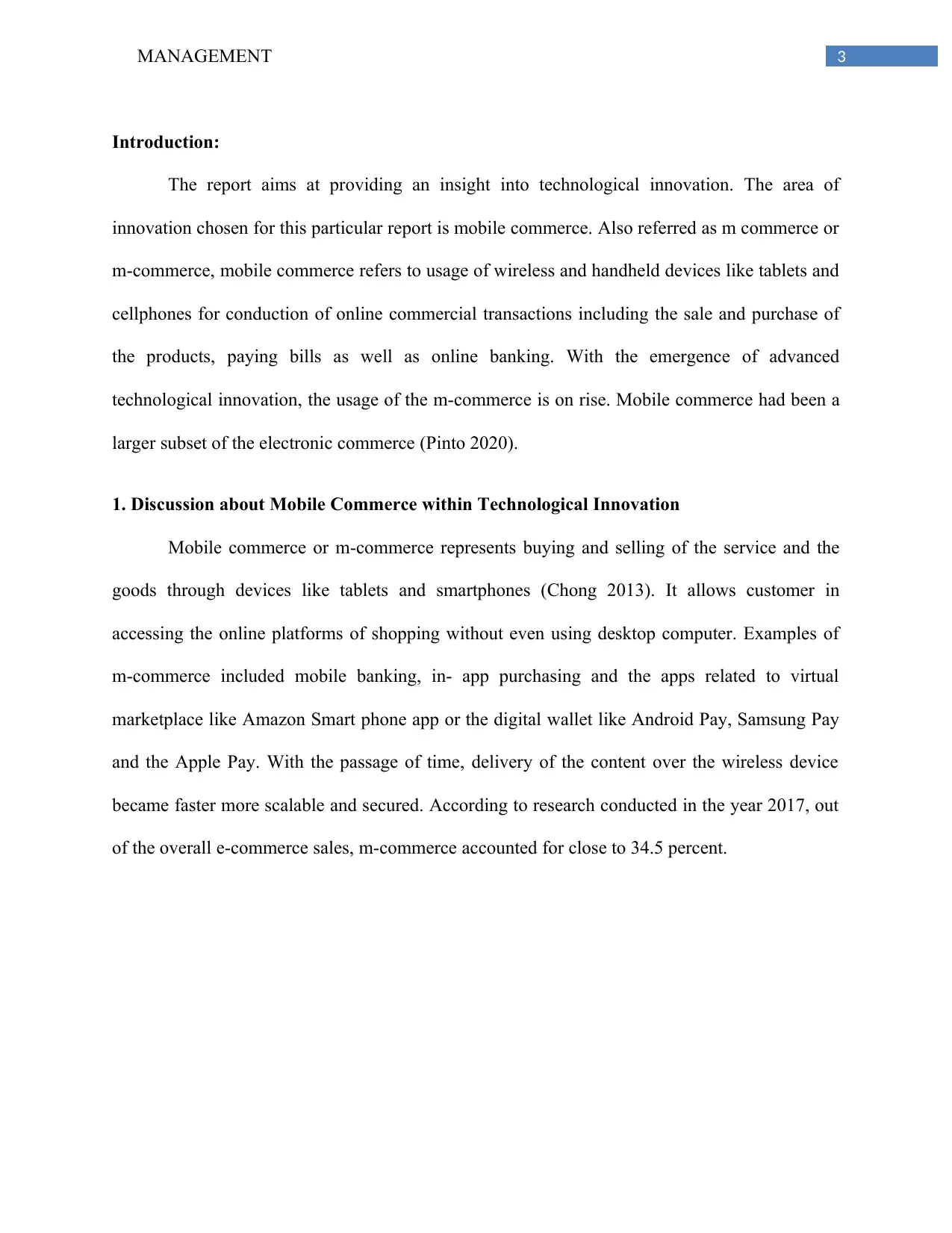
3MANAGEMENT
Introduction:
The report aims at providing an insight into technological innovation. The area of
innovation chosen for this particular report is mobile commerce. Also referred as m commerce or
m-commerce, mobile commerce refers to usage of wireless and handheld devices like tablets and
cellphones for conduction of online commercial transactions including the sale and purchase of
the products, paying bills as well as online banking. With the emergence of advanced
technological innovation, the usage of the m-commerce is on rise. Mobile commerce had been a
larger subset of the electronic commerce (Pinto 2020).
1. Discussion about Mobile Commerce within Technological Innovation
Mobile commerce or m-commerce represents buying and selling of the service and the
goods through devices like tablets and smartphones (Chong 2013). It allows customer in
accessing the online platforms of shopping without even using desktop computer. Examples of
m-commerce included mobile banking, in- app purchasing and the apps related to virtual
marketplace like Amazon Smart phone app or the digital wallet like Android Pay, Samsung Pay
and the Apple Pay. With the passage of time, delivery of the content over the wireless device
became faster more scalable and secured. According to research conducted in the year 2017, out
of the overall e-commerce sales, m-commerce accounted for close to 34.5 percent.
Introduction:
The report aims at providing an insight into technological innovation. The area of
innovation chosen for this particular report is mobile commerce. Also referred as m commerce or
m-commerce, mobile commerce refers to usage of wireless and handheld devices like tablets and
cellphones for conduction of online commercial transactions including the sale and purchase of
the products, paying bills as well as online banking. With the emergence of advanced
technological innovation, the usage of the m-commerce is on rise. Mobile commerce had been a
larger subset of the electronic commerce (Pinto 2020).
1. Discussion about Mobile Commerce within Technological Innovation
Mobile commerce or m-commerce represents buying and selling of the service and the
goods through devices like tablets and smartphones (Chong 2013). It allows customer in
accessing the online platforms of shopping without even using desktop computer. Examples of
m-commerce included mobile banking, in- app purchasing and the apps related to virtual
marketplace like Amazon Smart phone app or the digital wallet like Android Pay, Samsung Pay
and the Apple Pay. With the passage of time, delivery of the content over the wireless device
became faster more scalable and secured. According to research conducted in the year 2017, out
of the overall e-commerce sales, m-commerce accounted for close to 34.5 percent.
Paraphrase This Document
Need a fresh take? Get an instant paraphrase of this document with our AI Paraphraser
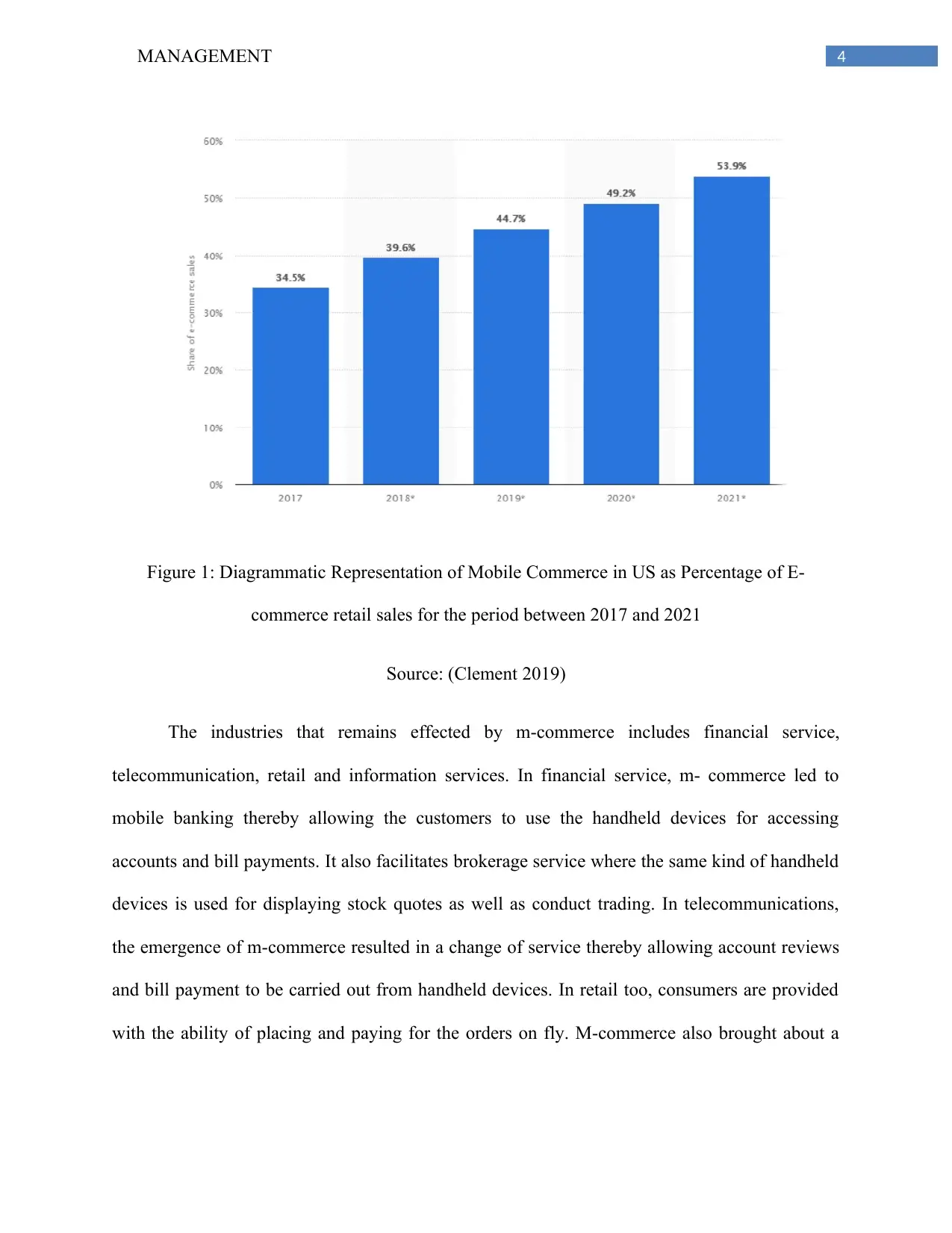
4MANAGEMENT
Figure 1: Diagrammatic Representation of Mobile Commerce in US as Percentage of E-
commerce retail sales for the period between 2017 and 2021
Source: (Clement 2019)
The industries that remains effected by m-commerce includes financial service,
telecommunication, retail and information services. In financial service, m- commerce led to
mobile banking thereby allowing the customers to use the handheld devices for accessing
accounts and bill payments. It also facilitates brokerage service where the same kind of handheld
devices is used for displaying stock quotes as well as conduct trading. In telecommunications,
the emergence of m-commerce resulted in a change of service thereby allowing account reviews
and bill payment to be carried out from handheld devices. In retail too, consumers are provided
with the ability of placing and paying for the orders on fly. M-commerce also brought about a
Figure 1: Diagrammatic Representation of Mobile Commerce in US as Percentage of E-
commerce retail sales for the period between 2017 and 2021
Source: (Clement 2019)
The industries that remains effected by m-commerce includes financial service,
telecommunication, retail and information services. In financial service, m- commerce led to
mobile banking thereby allowing the customers to use the handheld devices for accessing
accounts and bill payments. It also facilitates brokerage service where the same kind of handheld
devices is used for displaying stock quotes as well as conduct trading. In telecommunications,
the emergence of m-commerce resulted in a change of service thereby allowing account reviews
and bill payment to be carried out from handheld devices. In retail too, consumers are provided
with the ability of placing and paying for the orders on fly. M-commerce also brought about a
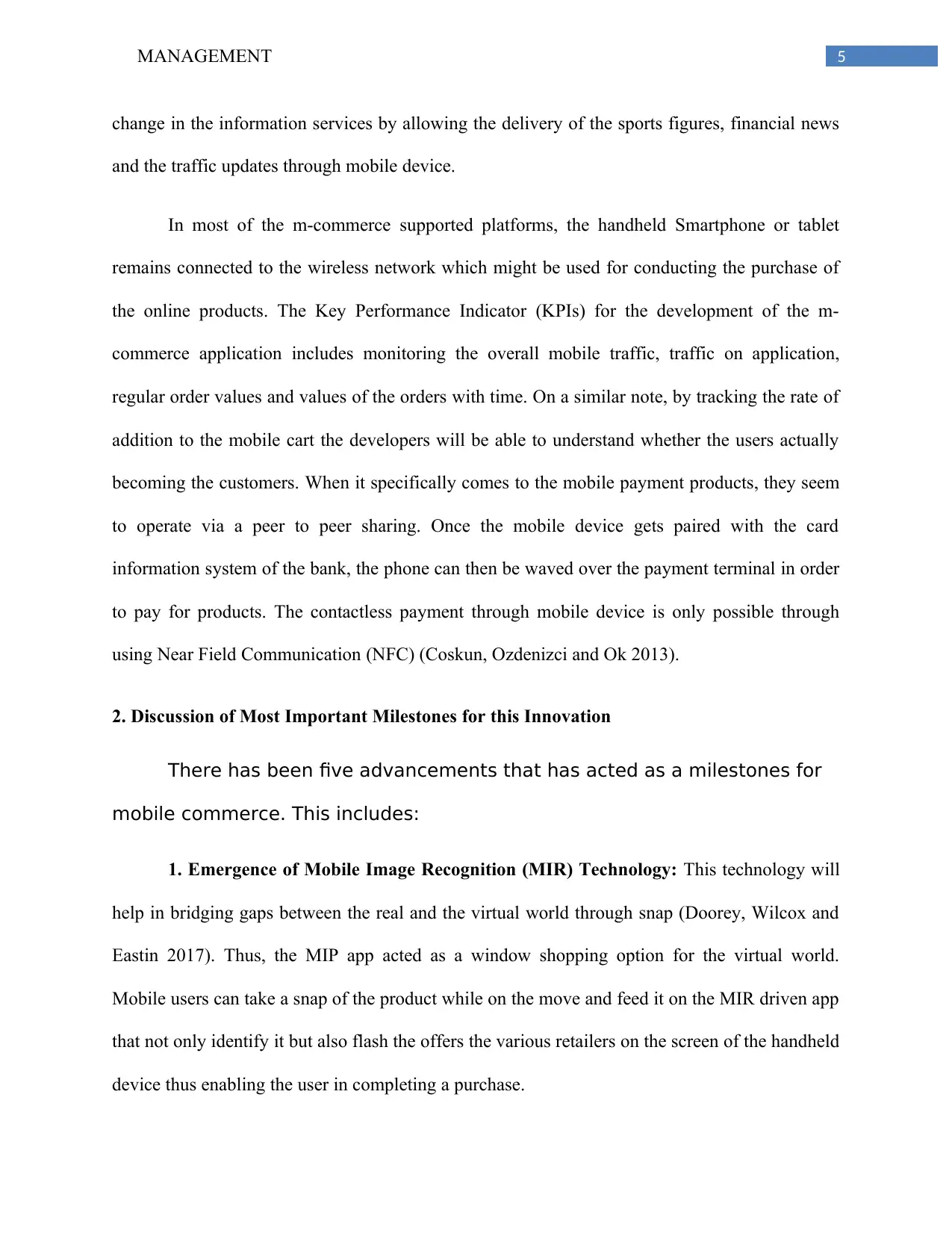
5MANAGEMENT
change in the information services by allowing the delivery of the sports figures, financial news
and the traffic updates through mobile device.
In most of the m-commerce supported platforms, the handheld Smartphone or tablet
remains connected to the wireless network which might be used for conducting the purchase of
the online products. The Key Performance Indicator (KPIs) for the development of the m-
commerce application includes monitoring the overall mobile traffic, traffic on application,
regular order values and values of the orders with time. On a similar note, by tracking the rate of
addition to the mobile cart the developers will be able to understand whether the users actually
becoming the customers. When it specifically comes to the mobile payment products, they seem
to operate via a peer to peer sharing. Once the mobile device gets paired with the card
information system of the bank, the phone can then be waved over the payment terminal in order
to pay for products. The contactless payment through mobile device is only possible through
using Near Field Communication (NFC) (Coskun, Ozdenizci and Ok 2013).
2. Discussion of Most Important Milestones for this Innovation
There has been five advancements that has acted as a milestones for
mobile commerce. This includes:
1. Emergence of Mobile Image Recognition (MIR) Technology: This technology will
help in bridging gaps between the real and the virtual world through snap (Doorey, Wilcox and
Eastin 2017). Thus, the MIP app acted as a window shopping option for the virtual world.
Mobile users can take a snap of the product while on the move and feed it on the MIR driven app
that not only identify it but also flash the offers the various retailers on the screen of the handheld
device thus enabling the user in completing a purchase.
change in the information services by allowing the delivery of the sports figures, financial news
and the traffic updates through mobile device.
In most of the m-commerce supported platforms, the handheld Smartphone or tablet
remains connected to the wireless network which might be used for conducting the purchase of
the online products. The Key Performance Indicator (KPIs) for the development of the m-
commerce application includes monitoring the overall mobile traffic, traffic on application,
regular order values and values of the orders with time. On a similar note, by tracking the rate of
addition to the mobile cart the developers will be able to understand whether the users actually
becoming the customers. When it specifically comes to the mobile payment products, they seem
to operate via a peer to peer sharing. Once the mobile device gets paired with the card
information system of the bank, the phone can then be waved over the payment terminal in order
to pay for products. The contactless payment through mobile device is only possible through
using Near Field Communication (NFC) (Coskun, Ozdenizci and Ok 2013).
2. Discussion of Most Important Milestones for this Innovation
There has been five advancements that has acted as a milestones for
mobile commerce. This includes:
1. Emergence of Mobile Image Recognition (MIR) Technology: This technology will
help in bridging gaps between the real and the virtual world through snap (Doorey, Wilcox and
Eastin 2017). Thus, the MIP app acted as a window shopping option for the virtual world.
Mobile users can take a snap of the product while on the move and feed it on the MIR driven app
that not only identify it but also flash the offers the various retailers on the screen of the handheld
device thus enabling the user in completing a purchase.
⊘ This is a preview!⊘
Do you want full access?
Subscribe today to unlock all pages.

Trusted by 1+ million students worldwide
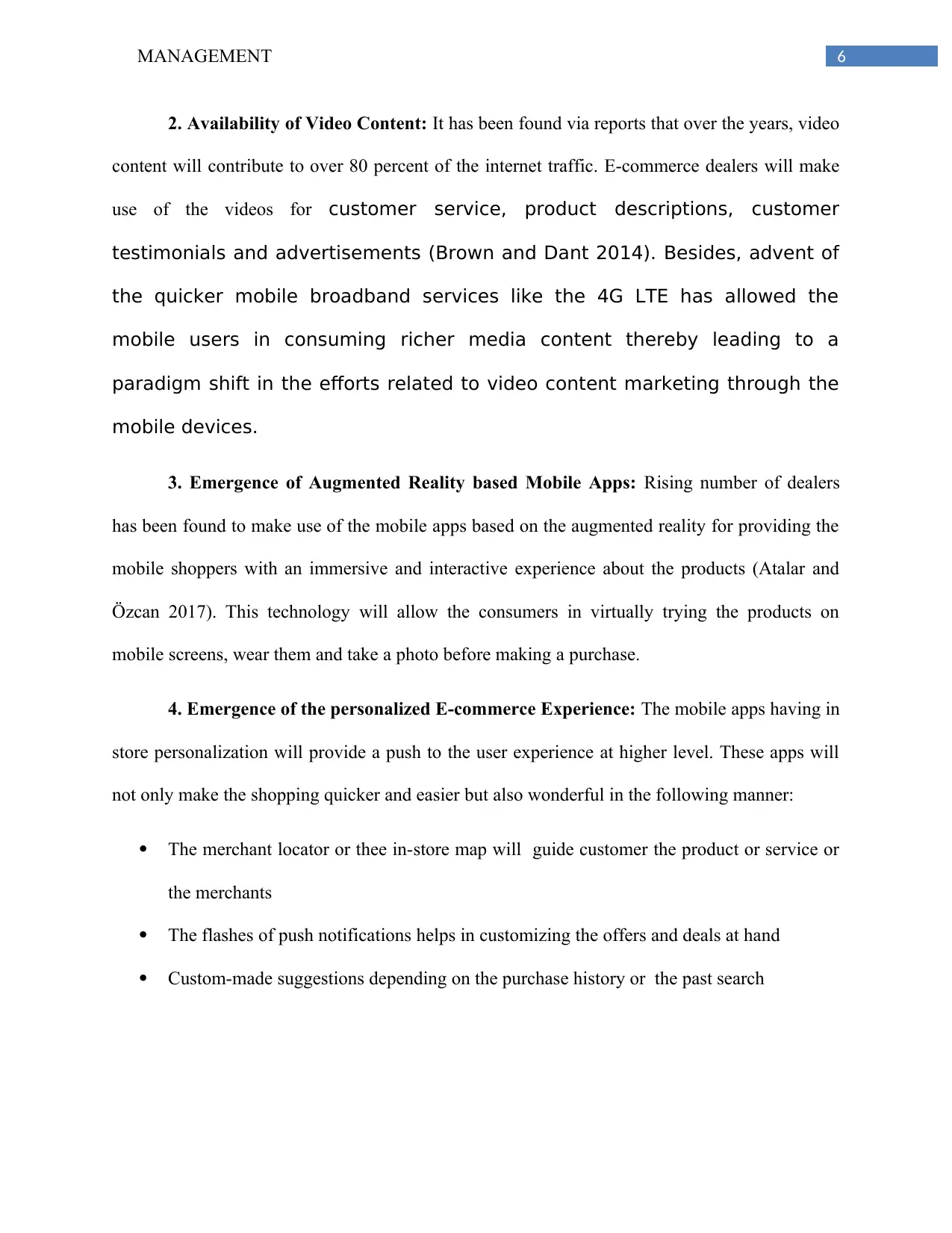
6MANAGEMENT
2. Availability of Video Content: It has been found via reports that over the years, video
content will contribute to over 80 percent of the internet traffic. E-commerce dealers will make
use of the videos for customer service, product descriptions, customer
testimonials and advertisements (Brown and Dant 2014). Besides, advent of
the quicker mobile broadband services like the 4G LTE has allowed the
mobile users in consuming richer media content thereby leading to a
paradigm shift in the efforts related to video content marketing through the
mobile devices.
3. Emergence of Augmented Reality based Mobile Apps: Rising number of dealers
has been found to make use of the mobile apps based on the augmented reality for providing the
mobile shoppers with an immersive and interactive experience about the products (Atalar and
Özcan 2017). This technology will allow the consumers in virtually trying the products on
mobile screens, wear them and take a photo before making a purchase.
4. Emergence of the personalized E-commerce Experience: The mobile apps having in
store personalization will provide a push to the user experience at higher level. These apps will
not only make the shopping quicker and easier but also wonderful in the following manner:
The merchant locator or thee in-store map will guide customer the product or service or
the merchants
The flashes of push notifications helps in customizing the offers and deals at hand
Custom-made suggestions depending on the purchase history or the past search
2. Availability of Video Content: It has been found via reports that over the years, video
content will contribute to over 80 percent of the internet traffic. E-commerce dealers will make
use of the videos for customer service, product descriptions, customer
testimonials and advertisements (Brown and Dant 2014). Besides, advent of
the quicker mobile broadband services like the 4G LTE has allowed the
mobile users in consuming richer media content thereby leading to a
paradigm shift in the efforts related to video content marketing through the
mobile devices.
3. Emergence of Augmented Reality based Mobile Apps: Rising number of dealers
has been found to make use of the mobile apps based on the augmented reality for providing the
mobile shoppers with an immersive and interactive experience about the products (Atalar and
Özcan 2017). This technology will allow the consumers in virtually trying the products on
mobile screens, wear them and take a photo before making a purchase.
4. Emergence of the personalized E-commerce Experience: The mobile apps having in
store personalization will provide a push to the user experience at higher level. These apps will
not only make the shopping quicker and easier but also wonderful in the following manner:
The merchant locator or thee in-store map will guide customer the product or service or
the merchants
The flashes of push notifications helps in customizing the offers and deals at hand
Custom-made suggestions depending on the purchase history or the past search
Paraphrase This Document
Need a fresh take? Get an instant paraphrase of this document with our AI Paraphraser
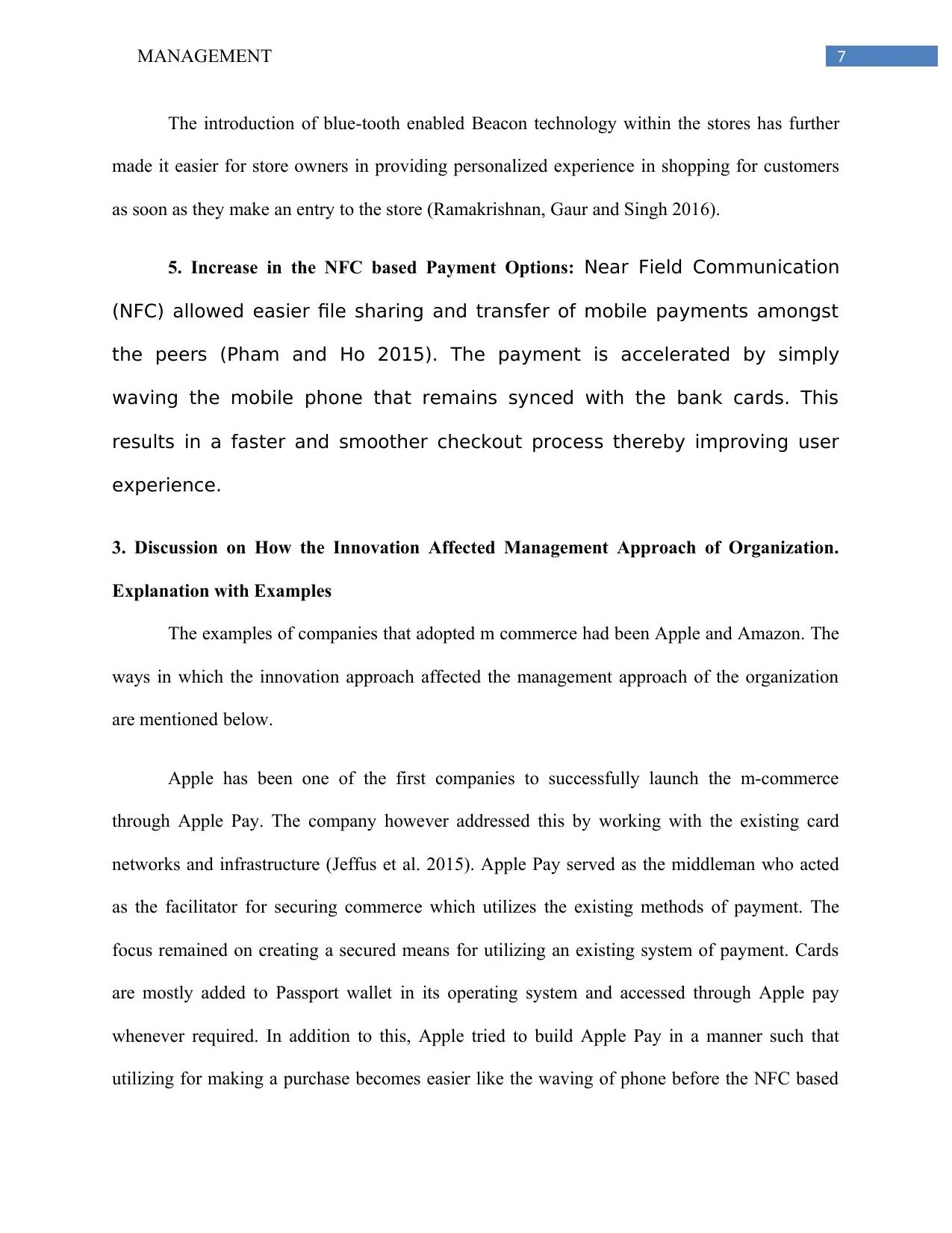
7MANAGEMENT
The introduction of blue-tooth enabled Beacon technology within the stores has further
made it easier for store owners in providing personalized experience in shopping for customers
as soon as they make an entry to the store (Ramakrishnan, Gaur and Singh 2016).
5. Increase in the NFC based Payment Options: Near Field Communication
(NFC) allowed easier file sharing and transfer of mobile payments amongst
the peers (Pham and Ho 2015). The payment is accelerated by simply
waving the mobile phone that remains synced with the bank cards. This
results in a faster and smoother checkout process thereby improving user
experience.
3. Discussion on How the Innovation Affected Management Approach of Organization.
Explanation with Examples
The examples of companies that adopted m commerce had been Apple and Amazon. The
ways in which the innovation approach affected the management approach of the organization
are mentioned below.
Apple has been one of the first companies to successfully launch the m-commerce
through Apple Pay. The company however addressed this by working with the existing card
networks and infrastructure (Jeffus et al. 2015). Apple Pay served as the middleman who acted
as the facilitator for securing commerce which utilizes the existing methods of payment. The
focus remained on creating a secured means for utilizing an existing system of payment. Cards
are mostly added to Passport wallet in its operating system and accessed through Apple pay
whenever required. In addition to this, Apple tried to build Apple Pay in a manner such that
utilizing for making a purchase becomes easier like the waving of phone before the NFC based
The introduction of blue-tooth enabled Beacon technology within the stores has further
made it easier for store owners in providing personalized experience in shopping for customers
as soon as they make an entry to the store (Ramakrishnan, Gaur and Singh 2016).
5. Increase in the NFC based Payment Options: Near Field Communication
(NFC) allowed easier file sharing and transfer of mobile payments amongst
the peers (Pham and Ho 2015). The payment is accelerated by simply
waving the mobile phone that remains synced with the bank cards. This
results in a faster and smoother checkout process thereby improving user
experience.
3. Discussion on How the Innovation Affected Management Approach of Organization.
Explanation with Examples
The examples of companies that adopted m commerce had been Apple and Amazon. The
ways in which the innovation approach affected the management approach of the organization
are mentioned below.
Apple has been one of the first companies to successfully launch the m-commerce
through Apple Pay. The company however addressed this by working with the existing card
networks and infrastructure (Jeffus et al. 2015). Apple Pay served as the middleman who acted
as the facilitator for securing commerce which utilizes the existing methods of payment. The
focus remained on creating a secured means for utilizing an existing system of payment. Cards
are mostly added to Passport wallet in its operating system and accessed through Apple pay
whenever required. In addition to this, Apple tried to build Apple Pay in a manner such that
utilizing for making a purchase becomes easier like the waving of phone before the NFC based
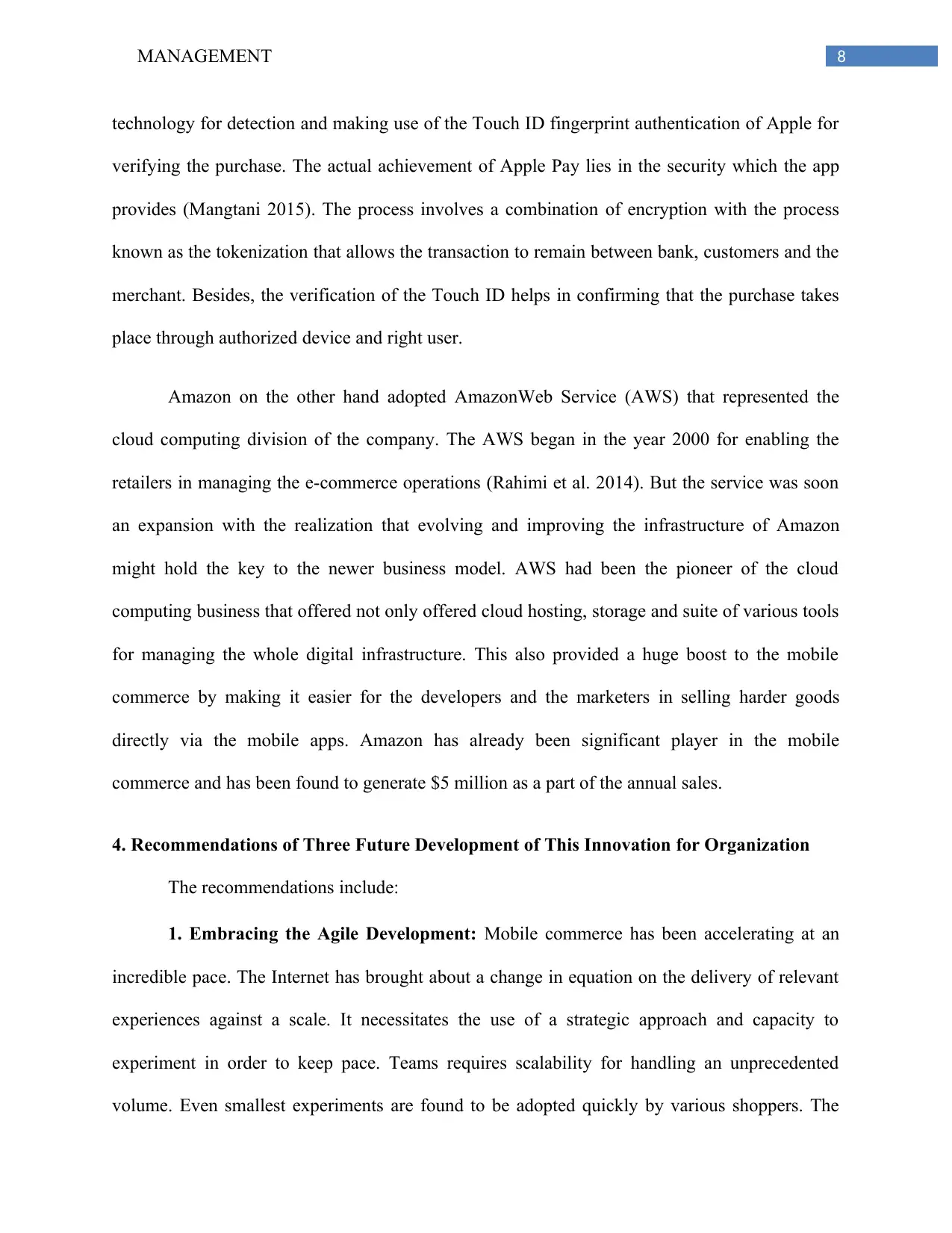
8MANAGEMENT
technology for detection and making use of the Touch ID fingerprint authentication of Apple for
verifying the purchase. The actual achievement of Apple Pay lies in the security which the app
provides (Mangtani 2015). The process involves a combination of encryption with the process
known as the tokenization that allows the transaction to remain between bank, customers and the
merchant. Besides, the verification of the Touch ID helps in confirming that the purchase takes
place through authorized device and right user.
Amazon on the other hand adopted AmazonWeb Service (AWS) that represented the
cloud computing division of the company. The AWS began in the year 2000 for enabling the
retailers in managing the e-commerce operations (Rahimi et al. 2014). But the service was soon
an expansion with the realization that evolving and improving the infrastructure of Amazon
might hold the key to the newer business model. AWS had been the pioneer of the cloud
computing business that offered not only offered cloud hosting, storage and suite of various tools
for managing the whole digital infrastructure. This also provided a huge boost to the mobile
commerce by making it easier for the developers and the marketers in selling harder goods
directly via the mobile apps. Amazon has already been significant player in the mobile
commerce and has been found to generate $5 million as a part of the annual sales.
4. Recommendations of Three Future Development of This Innovation for Organization
The recommendations include:
1. Embracing the Agile Development: Mobile commerce has been accelerating at an
incredible pace. The Internet has brought about a change in equation on the delivery of relevant
experiences against a scale. It necessitates the use of a strategic approach and capacity to
experiment in order to keep pace. Teams requires scalability for handling an unprecedented
volume. Even smallest experiments are found to be adopted quickly by various shoppers. The
technology for detection and making use of the Touch ID fingerprint authentication of Apple for
verifying the purchase. The actual achievement of Apple Pay lies in the security which the app
provides (Mangtani 2015). The process involves a combination of encryption with the process
known as the tokenization that allows the transaction to remain between bank, customers and the
merchant. Besides, the verification of the Touch ID helps in confirming that the purchase takes
place through authorized device and right user.
Amazon on the other hand adopted AmazonWeb Service (AWS) that represented the
cloud computing division of the company. The AWS began in the year 2000 for enabling the
retailers in managing the e-commerce operations (Rahimi et al. 2014). But the service was soon
an expansion with the realization that evolving and improving the infrastructure of Amazon
might hold the key to the newer business model. AWS had been the pioneer of the cloud
computing business that offered not only offered cloud hosting, storage and suite of various tools
for managing the whole digital infrastructure. This also provided a huge boost to the mobile
commerce by making it easier for the developers and the marketers in selling harder goods
directly via the mobile apps. Amazon has already been significant player in the mobile
commerce and has been found to generate $5 million as a part of the annual sales.
4. Recommendations of Three Future Development of This Innovation for Organization
The recommendations include:
1. Embracing the Agile Development: Mobile commerce has been accelerating at an
incredible pace. The Internet has brought about a change in equation on the delivery of relevant
experiences against a scale. It necessitates the use of a strategic approach and capacity to
experiment in order to keep pace. Teams requires scalability for handling an unprecedented
volume. Even smallest experiments are found to be adopted quickly by various shoppers. The
⊘ This is a preview!⊘
Do you want full access?
Subscribe today to unlock all pages.

Trusted by 1+ million students worldwide
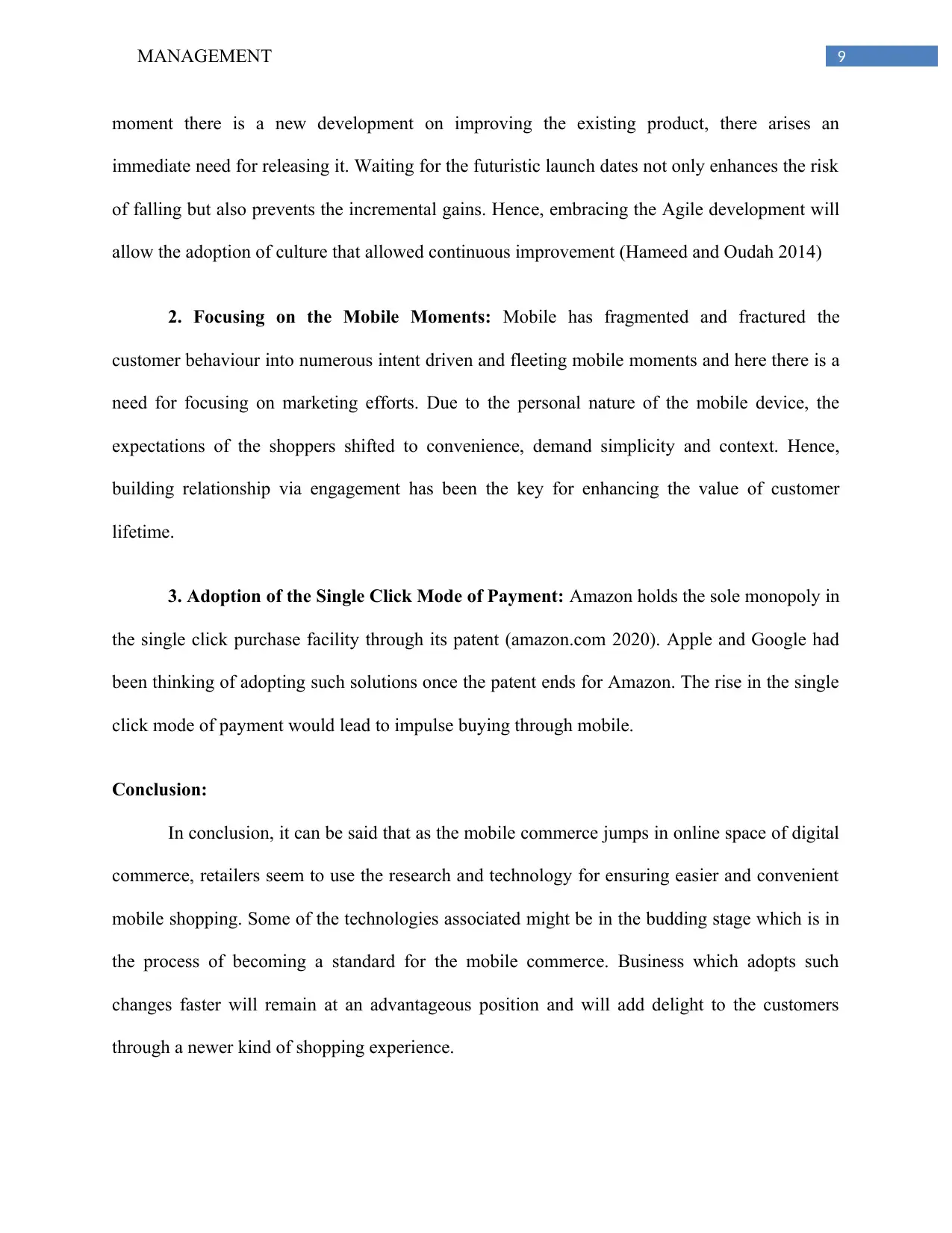
9MANAGEMENT
moment there is a new development on improving the existing product, there arises an
immediate need for releasing it. Waiting for the futuristic launch dates not only enhances the risk
of falling but also prevents the incremental gains. Hence, embracing the Agile development will
allow the adoption of culture that allowed continuous improvement (Hameed and Oudah 2014)
2. Focusing on the Mobile Moments: Mobile has fragmented and fractured the
customer behaviour into numerous intent driven and fleeting mobile moments and here there is a
need for focusing on marketing efforts. Due to the personal nature of the mobile device, the
expectations of the shoppers shifted to convenience, demand simplicity and context. Hence,
building relationship via engagement has been the key for enhancing the value of customer
lifetime.
3. Adoption of the Single Click Mode of Payment: Amazon holds the sole monopoly in
the single click purchase facility through its patent (amazon.com 2020). Apple and Google had
been thinking of adopting such solutions once the patent ends for Amazon. The rise in the single
click mode of payment would lead to impulse buying through mobile.
Conclusion:
In conclusion, it can be said that as the mobile commerce jumps in online space of digital
commerce, retailers seem to use the research and technology for ensuring easier and convenient
mobile shopping. Some of the technologies associated might be in the budding stage which is in
the process of becoming a standard for the mobile commerce. Business which adopts such
changes faster will remain at an advantageous position and will add delight to the customers
through a newer kind of shopping experience.
moment there is a new development on improving the existing product, there arises an
immediate need for releasing it. Waiting for the futuristic launch dates not only enhances the risk
of falling but also prevents the incremental gains. Hence, embracing the Agile development will
allow the adoption of culture that allowed continuous improvement (Hameed and Oudah 2014)
2. Focusing on the Mobile Moments: Mobile has fragmented and fractured the
customer behaviour into numerous intent driven and fleeting mobile moments and here there is a
need for focusing on marketing efforts. Due to the personal nature of the mobile device, the
expectations of the shoppers shifted to convenience, demand simplicity and context. Hence,
building relationship via engagement has been the key for enhancing the value of customer
lifetime.
3. Adoption of the Single Click Mode of Payment: Amazon holds the sole monopoly in
the single click purchase facility through its patent (amazon.com 2020). Apple and Google had
been thinking of adopting such solutions once the patent ends for Amazon. The rise in the single
click mode of payment would lead to impulse buying through mobile.
Conclusion:
In conclusion, it can be said that as the mobile commerce jumps in online space of digital
commerce, retailers seem to use the research and technology for ensuring easier and convenient
mobile shopping. Some of the technologies associated might be in the budding stage which is in
the process of becoming a standard for the mobile commerce. Business which adopts such
changes faster will remain at an advantageous position and will add delight to the customers
through a newer kind of shopping experience.
Paraphrase This Document
Need a fresh take? Get an instant paraphrase of this document with our AI Paraphraser
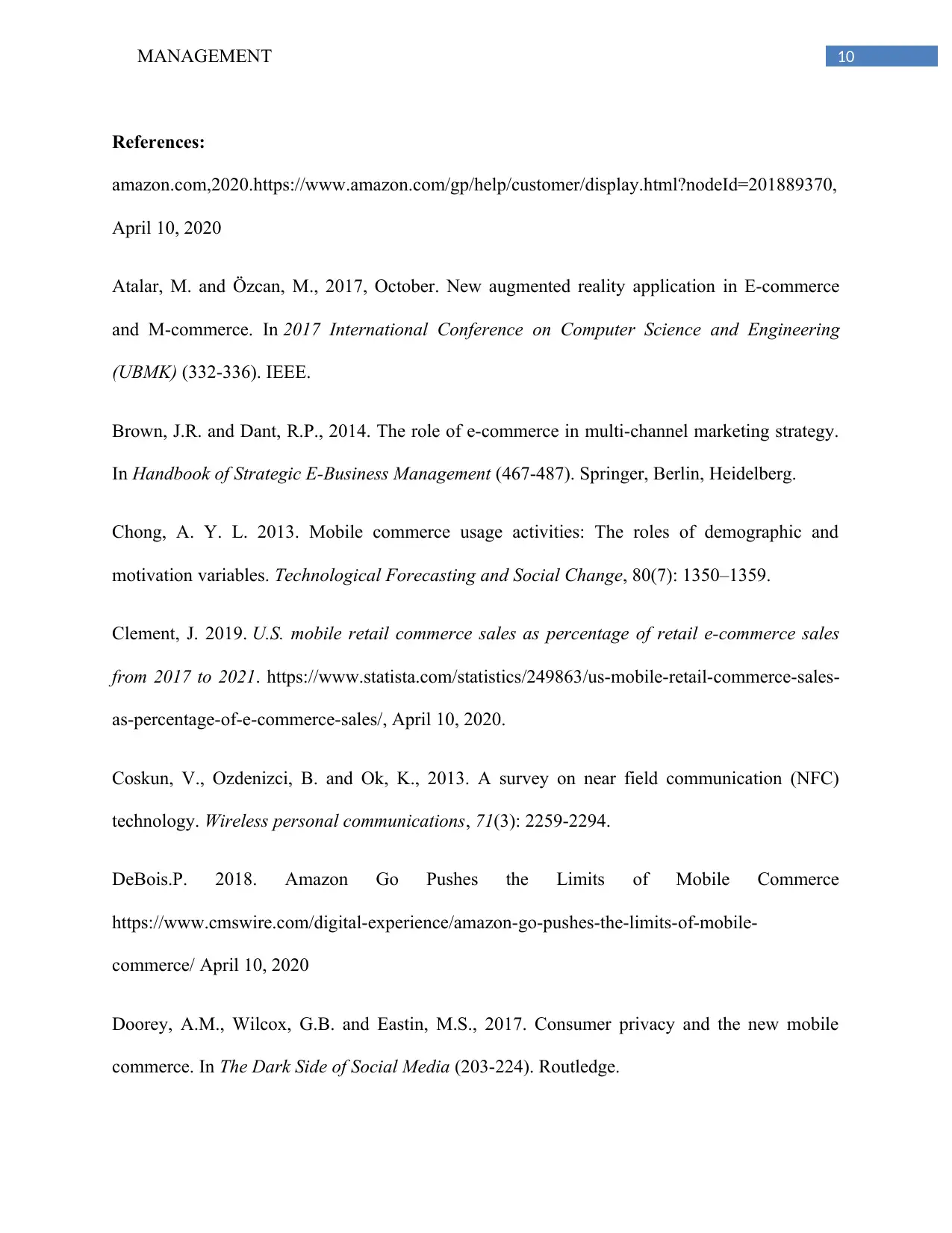
10MANAGEMENT
References:
amazon.com,2020.https://www.amazon.com/gp/help/customer/display.html?nodeId=201889370,
April 10, 2020
Atalar, M. and Özcan, M., 2017, October. New augmented reality application in E-commerce
and M-commerce. In 2017 International Conference on Computer Science and Engineering
(UBMK) (332-336). IEEE.
Brown, J.R. and Dant, R.P., 2014. The role of e-commerce in multi-channel marketing strategy.
In Handbook of Strategic E-Business Management (467-487). Springer, Berlin, Heidelberg.
Chong, A. Y. L. 2013. Mobile commerce usage activities: The roles of demographic and
motivation variables. Technological Forecasting and Social Change, 80(7): 1350–1359.
Clement, J. 2019. U.S. mobile retail commerce sales as percentage of retail e-commerce sales
from 2017 to 2021. https://www.statista.com/statistics/249863/us-mobile-retail-commerce-sales-
as-percentage-of-e-commerce-sales/, April 10, 2020.
Coskun, V., Ozdenizci, B. and Ok, K., 2013. A survey on near field communication (NFC)
technology. Wireless personal communications, 71(3): 2259-2294.
DeBois.P. 2018. Amazon Go Pushes the Limits of Mobile Commerce
https://www.cmswire.com/digital-experience/amazon-go-pushes-the-limits-of-mobile-
commerce/ April 10, 2020
Doorey, A.M., Wilcox, G.B. and Eastin, M.S., 2017. Consumer privacy and the new mobile
commerce. In The Dark Side of Social Media (203-224). Routledge.
References:
amazon.com,2020.https://www.amazon.com/gp/help/customer/display.html?nodeId=201889370,
April 10, 2020
Atalar, M. and Özcan, M., 2017, October. New augmented reality application in E-commerce
and M-commerce. In 2017 International Conference on Computer Science and Engineering
(UBMK) (332-336). IEEE.
Brown, J.R. and Dant, R.P., 2014. The role of e-commerce in multi-channel marketing strategy.
In Handbook of Strategic E-Business Management (467-487). Springer, Berlin, Heidelberg.
Chong, A. Y. L. 2013. Mobile commerce usage activities: The roles of demographic and
motivation variables. Technological Forecasting and Social Change, 80(7): 1350–1359.
Clement, J. 2019. U.S. mobile retail commerce sales as percentage of retail e-commerce sales
from 2017 to 2021. https://www.statista.com/statistics/249863/us-mobile-retail-commerce-sales-
as-percentage-of-e-commerce-sales/, April 10, 2020.
Coskun, V., Ozdenizci, B. and Ok, K., 2013. A survey on near field communication (NFC)
technology. Wireless personal communications, 71(3): 2259-2294.
DeBois.P. 2018. Amazon Go Pushes the Limits of Mobile Commerce
https://www.cmswire.com/digital-experience/amazon-go-pushes-the-limits-of-mobile-
commerce/ April 10, 2020
Doorey, A.M., Wilcox, G.B. and Eastin, M.S., 2017. Consumer privacy and the new mobile
commerce. In The Dark Side of Social Media (203-224). Routledge.
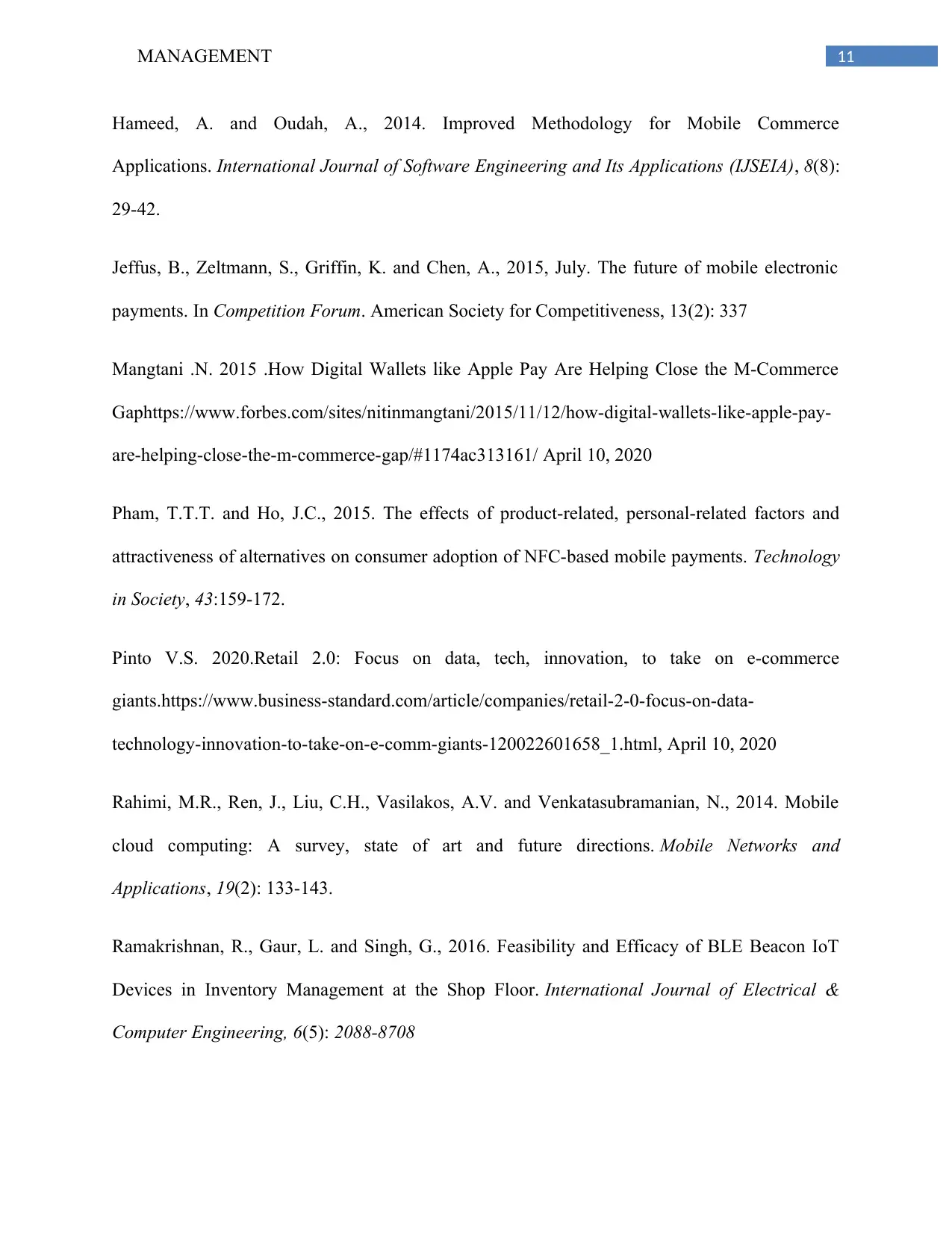
11MANAGEMENT
Hameed, A. and Oudah, A., 2014. Improved Methodology for Mobile Commerce
Applications. International Journal of Software Engineering and Its Applications (IJSEIA), 8(8):
29-42.
Jeffus, B., Zeltmann, S., Griffin, K. and Chen, A., 2015, July. The future of mobile electronic
payments. In Competition Forum. American Society for Competitiveness, 13(2): 337
Mangtani .N. 2015 .How Digital Wallets like Apple Pay Are Helping Close the M-Commerce
Gaphttps://www.forbes.com/sites/nitinmangtani/2015/11/12/how-digital-wallets-like-apple-pay-
are-helping-close-the-m-commerce-gap/#1174ac313161/ April 10, 2020
Pham, T.T.T. and Ho, J.C., 2015. The effects of product-related, personal-related factors and
attractiveness of alternatives on consumer adoption of NFC-based mobile payments. Technology
in Society, 43:159-172.
Pinto V.S. 2020.Retail 2.0: Focus on data, tech, innovation, to take on e-commerce
giants.https://www.business-standard.com/article/companies/retail-2-0-focus-on-data-
technology-innovation-to-take-on-e-comm-giants-120022601658_1.html, April 10, 2020
Rahimi, M.R., Ren, J., Liu, C.H., Vasilakos, A.V. and Venkatasubramanian, N., 2014. Mobile
cloud computing: A survey, state of art and future directions. Mobile Networks and
Applications, 19(2): 133-143.
Ramakrishnan, R., Gaur, L. and Singh, G., 2016. Feasibility and Efficacy of BLE Beacon IoT
Devices in Inventory Management at the Shop Floor. International Journal of Electrical &
Computer Engineering, 6(5): 2088-8708
Hameed, A. and Oudah, A., 2014. Improved Methodology for Mobile Commerce
Applications. International Journal of Software Engineering and Its Applications (IJSEIA), 8(8):
29-42.
Jeffus, B., Zeltmann, S., Griffin, K. and Chen, A., 2015, July. The future of mobile electronic
payments. In Competition Forum. American Society for Competitiveness, 13(2): 337
Mangtani .N. 2015 .How Digital Wallets like Apple Pay Are Helping Close the M-Commerce
Gaphttps://www.forbes.com/sites/nitinmangtani/2015/11/12/how-digital-wallets-like-apple-pay-
are-helping-close-the-m-commerce-gap/#1174ac313161/ April 10, 2020
Pham, T.T.T. and Ho, J.C., 2015. The effects of product-related, personal-related factors and
attractiveness of alternatives on consumer adoption of NFC-based mobile payments. Technology
in Society, 43:159-172.
Pinto V.S. 2020.Retail 2.0: Focus on data, tech, innovation, to take on e-commerce
giants.https://www.business-standard.com/article/companies/retail-2-0-focus-on-data-
technology-innovation-to-take-on-e-comm-giants-120022601658_1.html, April 10, 2020
Rahimi, M.R., Ren, J., Liu, C.H., Vasilakos, A.V. and Venkatasubramanian, N., 2014. Mobile
cloud computing: A survey, state of art and future directions. Mobile Networks and
Applications, 19(2): 133-143.
Ramakrishnan, R., Gaur, L. and Singh, G., 2016. Feasibility and Efficacy of BLE Beacon IoT
Devices in Inventory Management at the Shop Floor. International Journal of Electrical &
Computer Engineering, 6(5): 2088-8708
⊘ This is a preview!⊘
Do you want full access?
Subscribe today to unlock all pages.

Trusted by 1+ million students worldwide
1 out of 13
Related Documents
Your All-in-One AI-Powered Toolkit for Academic Success.
+13062052269
info@desklib.com
Available 24*7 on WhatsApp / Email
![[object Object]](/_next/static/media/star-bottom.7253800d.svg)
Unlock your academic potential
Copyright © 2020–2025 A2Z Services. All Rights Reserved. Developed and managed by ZUCOL.



